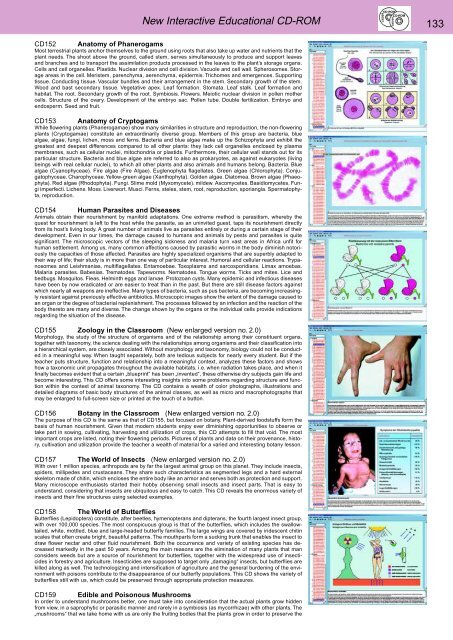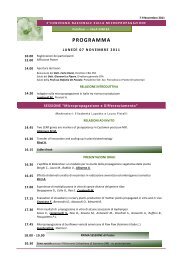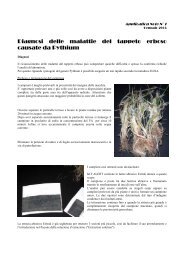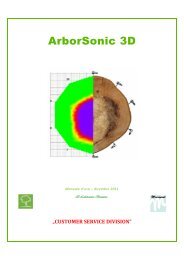BIOLOGY - microscopia.info
BIOLOGY - microscopia.info
BIOLOGY - microscopia.info
Create successful ePaper yourself
Turn your PDF publications into a flip-book with our unique Google optimized e-Paper software.
New Interactive Educational CD-ROM<br />
133<br />
CD152 Anatomy of Phanerogams<br />
Most terrestrial plants anchor themselves to the ground using roots that also take up water and nutrients that the<br />
plant needs. The shoot above the ground, called stem, serves simultaneously to produce and support leaves<br />
and branches and to transport the assimilation products processed in the leaves to the plant’s storage organs.<br />
Cells and cell organelles. Plastids. Nuclear division and cell division. Vacuole and cell wall. Spherosomes. Storage<br />
areas in the cell. Meristem, parenchyma, aerenchyma, epidermis. Trichomes and emergences. Supporting<br />
tissue. Conducting tissue. Vascular bundles and their arrangement in the stem. Secondary growth of the stem.<br />
Wood and bast secondary tissue. Vegetative apex. Leaf formation. Stomata. Leaf stalk. Leaf formation and<br />
habitat. The root. Secondary growth of the root. Symbiosis. Flowers. Meiotic nuclear division in pollen mother<br />
cells. Structure of the ovary. Development of the embryo sac. Pollen tube. Double fertilization. Embryo and<br />
endosperm. Seed and fruit.<br />
CD153 Anatomy of Cryptogams<br />
While flowering plants (Phanerogamae) show many similarities in structure and reproduction, the non-flowering<br />
plants (Cryptogamae) constitute an extraordinarily diverse group. Members of this group are bacteria, blue<br />
algae, algae, fungi, lichen, moss and ferns. Bacteria and blue algae make up the Schizophyta and exhibit the<br />
greatest and deepest differences compared to all other plants: they lack cell organelles enclosed by plasma<br />
membranes, such as cellular nuclei, mitochondria or plastids. Furthermore, their cellular wall stands out for its<br />
particular structure. Bacteria and blue algae are referred to also as prokaryotes, as against eukaryotes (living<br />
beings with real cellular nuclei), to which all other plants and also animals and humans belong. Bacteria. Blue<br />
algae (Cyanophyceae). Fire algae (Fire Algae). Euglenophyta flagellates. Green algae (Chlorophyta). Conjugatophyceae.<br />
Charophyceae. Yellow-green algae (Xanthophyta). Golden algae. Diatomea. Brown algae (Phaeophyta).<br />
Red algae (Rhodophyta). Fungi. Slime mold (Myxomycete). mildew. Ascomycetes. Basidiomycetes. Fungi<br />
imperfecti. Lichens. Moss. Liverwort. Musci. Ferns, steles, stem, root, reproduction, sporiangia. Spermatophyta,<br />
reproduction.<br />
CD154 Human Parasites and Diseases<br />
Animals obtain their nourishment by manifold adaptations. One extreme method is parasitism, whereby the<br />
quest for nourishment is left to the host while the parasite, as an uninvited guest, taps its nourishment directly<br />
from its host’s living body. A great number of animals live as parasites entirely or during a certain stage of their<br />
development. Even in our times, the damage caused to humans and animals by pests and parasites is quite<br />
significant. The microscopic vectors of the sleeping sickness and malaria turn vast areas in Africa unfit for<br />
human settlement. Among us, many common affections caused by parasitic worms in the body diminish notoriously<br />
the capacities of those affected. Parasites are highly specialized organisms that are superbly adapted to<br />
their way of life; their study is in more than one way of particular interest. Humoral and cellular reactions. Trypanosomes<br />
and Leishmanias, multiflagellates. Entamoebae. Toxoplasms and sarcosporidians. Limax amoebas.<br />
Malaria parasites. Babesias. Trematodes. Tapeworms. Nematodes. Tongue worms. Ticks and mites. Lice and<br />
bedbugs. Mosquitos. Fleas. Helminth eggs and larvae. Protozoan cysts. Many epidemic and infectious diseases<br />
have been by now eradicated or are easier to treat than in the past. But there are still disease factors against<br />
which nearly all weapons are ineffective. Many types of bacteria, such as pus bacteria, are becoming increasingly<br />
resistant against previously effective antibiotics. Microscopic images show the extent of the damage caused to<br />
an organ or the degree of bacterial replenishment. The processes followed by an infection and the reaction of the<br />
body thereto are many and diverse. The change shown by the organs or the individual cells provide indications<br />
regarding the situation of the disease.<br />
CD155 Zoology in the Classroom (New enlarged version no. 2.0)<br />
Morphology, the study of the structure of organisms and of the relationship among their constituent organs,<br />
together with taxonomy, the science dealing with the relationships among organisms and their classification into<br />
a hierarchical system, are closely associated. Without morphology and taxonomy, biology could not be conducted<br />
in a meaningful way. When taught separately, both are tedious subjects for nearly every student. But if the<br />
teacher puts structure, function and relationship into a meaningful context, analyzes these factors and shows<br />
how a taxonomic unit propagates throughout the available habitats, i.e. when radiation takes place, and when it<br />
finally becomes evident that a certain „blueprint“ has been „invented“, these otherwise dry subjects gain life and<br />
become interesting. This CD offers some interesting insights into some problems regarding structure and function<br />
within the context of animal taxonomy. The CD contains a wealth of color photographs, illustrations and<br />
detailed diagrams of basic body structures of the animal classes, as well as micro and macrophotographs that<br />
may be enlarged to full-screen size or printed at the touch of a button.<br />
CD156 Botany in the Classroom (New enlarged version no. 2.0)<br />
The purpose of this CD is the same as that of CD155, but focused on botany. Plant-derived foodstuffs form the<br />
basis of human nourishment. Given that modern students enjoy ever diminishing opportunities to observe or<br />
take part in sowing, cultivating, harvesting and utilization of crops, this CD attempts to fill that void. The most<br />
important crops are listed, noting their flowering periods. Pictures of plants and data on their provenance, history,<br />
cultivation and utilization provide the teacher a wealth of material for a varied and interesting botany lesson.<br />
CD157 The World of Insects (New enlarged version no. 2.0)<br />
With over 1 million species, arthropods are by far the largest animal group on this planet. They include insects,<br />
spiders, millipedes and crustaceans. They share such characteristics as segmented legs and a hard external<br />
skeleton made of chitin, which encloses the entire body like an armor and serves both as protection and support.<br />
Many microscope enthusiasts started their hobby observing small insects and insect parts. That is easy to<br />
understand, considering that insects are ubiquitous and easy to catch. This CD reveals the enormous variety of<br />
insects and their fine structures using selected examples.<br />
CD158 The World of Butterflies<br />
Butterflies (Lepidoptera) constitute, after beetles, hymenopterans and dipterans, the fourth largest insect group,<br />
with over 100,000 species. The most conspicuous group is that of the butterflies, which includes the swallowtailed,<br />
white, mottled, blue and large-headed butterfly families. The large wings are covered by iridescent chitin<br />
scales that often create bright, beautiful patterns. The mouthparts form a sucking trunk that enables the insect to<br />
draw flower nectar and other fluid nourishment. Both the occurrence and variety of existing species has decreased<br />
markedly in the past 50 years. Among the main reasons are the elimination of many plants that man<br />
considers weeds but are a source of nourishment for butterflies, together with the widespread use of insecticides<br />
in forestry and agriculture. Insecticides are supposed to target only „damaging“ insects, but butterflies are<br />
killed along as well. The technologizing and intensification of agriculture and the general burdening of the environment<br />
with poisons contribute to the disappearance of our butterfly populations. This CD shows the variety of<br />
butterflies still with us, which could be preserved through appropriate protection measures.<br />
CD159 Edible and Poisonous Mushrooms<br />
In order to understand mushrooms better, one must take into consideration that the actual plants grow hidden<br />
from view, in a saprophytic or parasitic manner and rarely in a symbiosis (as mycorrhizae) with other plants. The<br />
„mushrooms“ that we take home with us are only the fruiting bodies that the plants grow in order to preserve the







